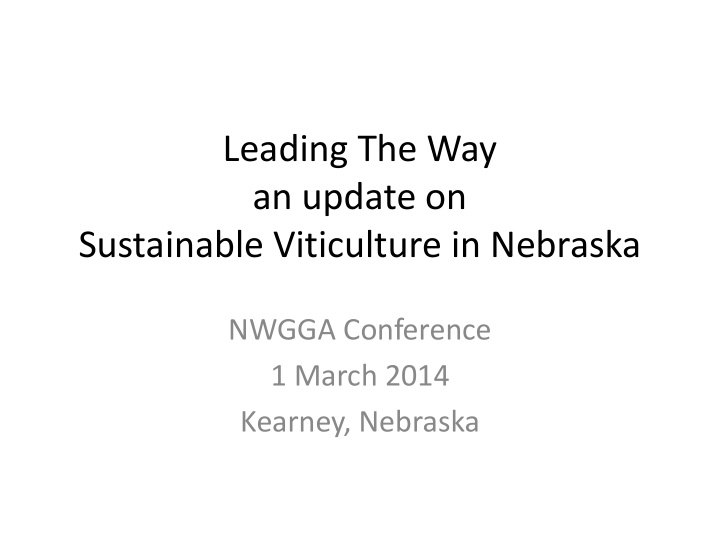



Leading The Way an update on Sustainable Viticulture in Nebraska NWGGA Conference 1 March 2014 Kearney, Nebraska
Introduction • Nebraska Renewable Energy Systems was founded in 2005 to help develop renewable energy in NE • Operated and off-grid farm since 2006 • Produced first biodiesel in Nebraska and many other firsts. • Spun off two other projects, a renewable fuels filling station and a seed processing facility • The seed processing facility, called Nebraska Screw Press has been involved with oilseed expelling for many years now.
How Nebraska Screw Press got here • Oils from the farm remain a strong part of Nebraska history which we sought to redevelop • Strong interest in sustainable Biofuels was the reason for our initial involvement with vegetable oil recovery systems in 2004 • 2008 saw biofuels essentially disappear in Nebraska, activities all but ended • 2010 saw us get involved with food grade oils and equipment that has seen increasing popularity • Transfer of NRES research to NSP for development
Energy Balance in the Vineyard • Energy to grow • Energy to harvest • Energy to crush • Energy to ferment • Energy to bottle • Energy to market Can this be offset? What extent?
Energy in a bottle • Average kWh consumption per case of finished wine varies from 6-20kWh per case. • Most inputs are fossil fuel based • Opportunities for conservation are limited • Winery size does not correlate to energy investment in the wine • Nebraska rates are rapidly increasing due to reliance on imported energy sources, recently moving from 5 th lowest to 17 th lowest in US.
Renewable Energy and Viticulture are a great mix • Those involved in viticulture have expressed a strong interest in sustainable energy inputs to their process in our three state survey • Customers of the tasting room appreciate the value of sustainable and locally grown products • Renewable Energy and pomace recovery products can help differentiate the tasting room experience and increase traffic to the winery
Silver Hills Winery • Performed full energy audit • Had energy intensity calculated at 6kWh/case • Installed 6.6kw of solar to offset winery energy usage • Added 3kw of wind in 2013 with energy back up system • Recycles Pomace annually • Supports Intern education projects • Became energy neutral Winery
Renewable Energy Systems • Two years remain for 30% Electricity Consum ption Federal tax Credit 16000 14000 • Net Metering Expansion likely 12000 10000 kw Purchased 2006 • Solar warranties out to 25 years 8000 2007 2008 6000 • $5/watt for installed rooftop or 4000 2000 ground mount solar 0 y y h l y e y t r r r r i s e e e e r r c r a n l a a p u u b b b b r M u a A J g u u J m o m m M n r u t b e c e e a A O v c J e t F p o e • Hybrid technology now Month e D N S mainstream • Vertical south face walls are solar collectors for thermal solar • Grape seed biomass energy conversion well documented
Anticipated Program Benefits • Reduce energy expenditures • Generate tax credits on energy infrastructure • Visible commitment to sustainability • Accentuate prepared food at wineries with grape seed flour and oil materials • Expand product offerings from Nebraska Vineyards • Create economic activity and job creation through recycling grape seed pomace
You want what? What do you want that for? • Pomace recovery an excellent example of recycling and adding value • Reminiscent of used fryer oil recovery discussion • Excellent opportunity to create additional products from the vineyard • Material is created annually • Many challenges needed to be overcome
Program roots • Began field research back in 2009 when Mac’s Creek dumped a truck load of pomace at a potential biodiesel site in central Nebraska • Shelf stability primary concern when produced • Silver Hills early interest and support • NRES internship program adopted vineyard energy survey projects • Collection and processing began in 2011 • NET/NDEQ grant support in 2013
2013 Season • Infrastructural investments made to enable expanded pomace recovery, about $40k • Recycled 25 tons of material - Soaring Wings 8 tons - Milleta Vista 7 tons - Silver Hills 5 tons - James Arthur 5 tons - Big Cottonwood 1 ton
2013 Season • Solar powered process • Many fractions created from seed cleaning process • White grape seed oil, types • Improved flour texture • Feed trials ongoing with dried materials • Market development work ongoing • Identified pomace collection system needs • Began development of grape seed blended products. • Drying step limiting factor
Major Lessons Learned • Properties of oil • Wet Separation techniques • Solar Drying • Cleaning and Grinding • Manual labor demands are high • Mileage investment in pomace can be high without good planning and coordination • We are grateful for contributing winery support
Future Work - 2014 • Increase Macro bin inventory (looking for used!) • Larger recovery trailer, better coordination • OSU optimization study results • Improved drying techniques • Marketing • Packaging • Expand collection to 50 tons • Recipe expansion • Further Grinding • Consolidate nutritional features
NSP Sustainable Viticulture Support Services • Vineyard and Winery Energy Assessments • Renewable Energy offset/backup systems • Pomace recycling services • Oil/flour marketing and branding in the Tasting Room • Permits, tax credit and grant technical support services
Thank you to all our Partners • Nebraska Environmental Trust and NDEQ • Silver Hills Winery • Contributing Wineries • UNL Biochemistry and OSU • NRES Student interns • NWGGA /Jennifer Montgomery for this time • We appreciate the opportunity to work with the viticulture industry
Recommend
More recommend